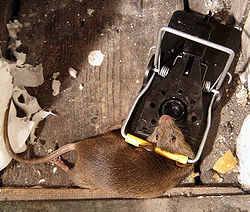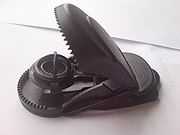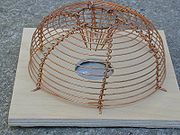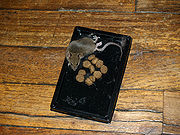
Mousetrap
Encyclopedia

Mouse
A mouse is a small mammal belonging to the order of rodents. The best known mouse species is the common house mouse . It is also a popular pet. In some places, certain kinds of field mice are also common. This rodent is eaten by large birds such as hawks and eagles...
; however, it may also trap other small animals. Mousetraps are usually set in an indoor location where there is a suspected infestation of rodent
Rodent
Rodentia is an order of mammals also known as rodents, characterised by two continuously growing incisors in the upper and lower jaws which must be kept short by gnawing....
s. There are various types of mousetrap, each with its own advantages and disadvantages. Larger traps are designed to catch other species of animals; such as rat
Rat
Rats are various medium-sized, long-tailed rodents of the superfamily Muroidea. "True rats" are members of the genus Rattus, the most important of which to humans are the black rat, Rattus rattus, and the brown rat, Rattus norvegicus...
s, squirrel
Squirrel
Squirrels belong to a large family of small or medium-sized rodents called the Sciuridae. The family includes tree squirrels, ground squirrels, chipmunks, marmots , flying squirrels, and prairie dogs. Squirrels are indigenous to the Americas, Eurasia, and Africa and have been introduced to Australia...
s, other small rodents, or other animals.
Spring-loaded bar mousetrap


James Henry Atkinson
James Henry Atkinson was a British ironmonger from Leeds, Yorkshire who invented the mousetrap. Atkinson invented a number of items, but his mousetrap, known as the Little Nipper which he patented in 1897, remains the most well known mousetrap invention to date.-Little Nipper:James Henry Atkinson...
, a British inventor who in 1897 invented a prototype called the "Little Nipper", probably had seen the Hooker trap in the shops or in advertisements and used it as the basis of his model.
It is a simple device with a heavily spring-loaded bar and a trip to release it. Cheese
Cheese
Cheese is a generic term for a diverse group of milk-based food products. Cheese is produced throughout the world in wide-ranging flavors, textures, and forms....
may be placed on the trip as bait
Bait (luring substance)
Bait is any substance used to attract prey, e.g. in a mousetrap.-In Australia:Baiting in Australia refers to specific campaigns to control foxes, wild dogs and dingos by poisoning in areas where they are a problem...
, but other food such as oats, chocolate
Chocolate
Chocolate is a raw or processed food produced from the seed of the tropical Theobroma cacao tree. Cacao has been cultivated for at least three millennia in Mexico, Central and South America. Its earliest documented use is around 1100 BC...
, bread
Bread
Bread is a staple food prepared by cooking a dough of flour and water and often additional ingredients. Doughs are usually baked, but in some cuisines breads are steamed , fried , or baked on an unoiled frying pan . It may be leavened or unleavened...
, meat
Meat
Meat is animal flesh that is used as food. Most often, this means the skeletal muscle and associated fat and other tissues, but it may also describe other edible tissues such as organs and offal...
, butter
Butter
Butter is a dairy product made by churning fresh or fermented cream or milk. It is generally used as a spread and a condiment, as well as in cooking applications, such as baking, sauce making, and pan frying...
and peanut butter
Peanut butter
Peanut butter is a food paste made primarily from ground dry roasted peanuts, popular in North America, Netherlands, United Kingdom, and parts of Asia, particularly the Philippines and Indonesia. It is mainly used as a sandwich spread, sometimes in combination as in the peanut butter and jelly...
are commonly used. The spring-loaded bar swings down rapidly and with great force when anything, usually a mouse, touches the trip. The design is such that the mouse's neck or spinal cord
Spinal cord
The spinal cord is a long, thin, tubular bundle of nervous tissue and support cells that extends from the brain . The brain and spinal cord together make up the central nervous system...
will be broken, or its rib
Rib
In vertebrate anatomy, ribs are the long curved bones which form the rib cage. In most vertebrates, ribs surround the chest, enabling the lungs to expand and thus facilitate breathing by expanding the chest cavity. They serve to protect the lungs, heart, and other internal organs of the thorax...
s or skull
Skull
The skull is a bony structure in the head of many animals that supports the structures of the face and forms a cavity for the brain.The skull is composed of two parts: the cranium and the mandible. A skull without a mandible is only a cranium. Animals that have skulls are called craniates...
crushed, by the force of the bar. The trap can be held over a toilet or bin and the dead mouse released into it by pulling the bar. Rats
RATS
RATS may refer to:* RATS , Regression Analysis of Time Series, a statistical package* Rough Auditing Tool for Security, a computer program...
are much larger than mice; a much larger version of the same type of trap
Rat trap
A rat trap is a trap designed to catch rats.Rats are suspicious of new objects and traps with only one entrance. If they see other rats have been trapped they may avoid the trap. Traps which do not address these issues are likely to catch only young, inexperienced rats, not the older ones.Spring...
is used to kill them. Some spring mouse traps have a plastic extended trigger made to look like a piece of cheese. The larger trigger has two advantages over the smaller traditional type:1)increased leverage, which requires less force from the rodent to trip it and 2) the larger surface area of the trigger increases the probability of even the most cunning of rodents to set off the trap.
In 1899, John Mast of Lititz, Pennsylvania, filed a U.S. patent for a modification of Hooker's design that can be "readily set or adjusted with absolute safety to the person attending thereto, avoiding the liability of having his fingers caught or injured by the striker when it is prematurely or accidentally freed or released." He obtained the patent at Nov. 17, 1903.
Some modern plastic designs can be set by the pressure of a single finger on a tab.
Mouth mousetrap

Electric mousetrap
This more recent type of mousetrap delivers a lethal dose of electricity when the rodent completes the circuit by contacting two electrodes located either at the entrance or between the entrance and the bait. The electrodes are housed in an insulated or plastic box to prevent accidental injury to humans and pets. They can be designed for single-catch domestic use or large multiple-catch commercial use. See andLive-catching mousetraps

It is important to release the mouse promptly – as mice can die from stress or dehydration – and at some distance, as mice have a strong homing instinct. Survival after release is not guaranteed, since house mice
House mouse
The house mouse is a small rodent, a mouse, one of the most numerous species of the genus Mus.As a wild animal the house mouse mainly lives associated with humans, causing damage to crops and stored food....
will tend to seek out human buildings, where they might encounter lethal mousetraps or may be eaten by predators. In the wild, house mice are very poor competitors, and cannot survive away from human settlements in areas where other small mammals, such as wood mice
Wood mouse
The wood mouse is a common murid rodent from Europe and northwestern Africa. It is closely related to the yellow-necked mouse but differs in that it has no band of yellow fur around the neck, has slightly smaller ears, and is usually slightly smaller overall: around 90 mm in length...
, are present.
Glue traps

Glue
This is a list of various types of glue. Historically, the term "glue" only referred to protein colloids prepared from animal flesh. The meaning has been extended to refer to any fluid adhesive....
traps are made using natural or synthetic adhesive applied to cardboard
Paperboard
Paperboard is a thick paper based material. While there is no rigid differentiation between paper and paperboard, paperboard is generally thicker than paper. According to ISO standards, paperboard is a paper with a basis weight above 224 g/m2, but there are exceptions. Paperboard can be single...
, plastic trays or similar material. Bait
Bait (luring substance)
Bait is any substance used to attract prey, e.g. in a mousetrap.-In Australia:Baiting in Australia refers to specific campaigns to control foxes, wild dogs and dingos by poisoning in areas where they are a problem...
can be placed in the center or a scent may be added to the adhesive by the manufacturer. Glue traps are used primarily for rodent
Rodent
Rodentia is an order of mammals also known as rodents, characterised by two continuously growing incisors in the upper and lower jaws which must be kept short by gnawing....
control indoors. Glue traps are not effective outdoors due to environmental conditions (moisture
Moisture
Humidity is the amount of moisture the air can hold before it rains. Moisture refers to the presence of a liquid, especially water, often in trace amounts...
, dust
Dust
Dust consists of particles in the atmosphere that arise from various sources such as soil dust lifted up by wind , volcanic eruptions, and pollution...
), which quickly render the adhesive ineffective. Glue strip or glue tray devices trap the mouse in the sticky glue.
Glue traps sometimes do not kill the rodent, which requires http://www.ipm.ucdavis.edu/PMG/PESTNOTES/pn74106.html you to kill the rodent before disposal. This is an advantage if the local population of rodents have rat mites since the mite will remain on the rodents' body while it is still alive and the glue would also trap mites leaving the rodent after the rodents' death.
Animals can be released from the glue by applying vegetable oil and gently working the animal free. This is sometimes not possible, however, due to the mouse sustaining injuries before the trap is noticed or getting their faces stuck and suffocating. Many animals trapped by these devices sustain severe injuries including severed limbs and torn skin caused by gnawing them off themselves to try to escape. Nevertheless, these types of traps are effective and non-toxic to humans.
Death
Death
Death is the permanent termination of the biological functions that sustain a living organism. Phenomena which commonly bring about death include old age, predation, malnutrition, disease, and accidents or trauma resulting in terminal injury....
is much slower than with the traditional type trap, which has prompted animal activists and welfare organisations such as PETA
People for the Ethical Treatment of Animals
People for the Ethical Treatment of Animals is an American animal rights organization based in Norfolk, Virginia, and led by Ingrid Newkirk, its international president. A non-profit corporation with 300 employees and two million members and supporters, it claims to be the largest animal rights...
and the RSPCA to oppose the use of glue traps. Trapped mice eventually die from exposure
Hypothermia
Hypothermia is a condition in which core temperature drops below the required temperature for normal metabolism and body functions which is defined as . Body temperature is usually maintained near a constant level of through biologic homeostasis or thermoregulation...
, dehydration
Dehydration
In physiology and medicine, dehydration is defined as the excessive loss of body fluid. It is literally the removal of water from an object; however, in physiological terms, it entails a deficiency of fluid within an organism...
, starvation
Starvation
Starvation is a severe deficiency in caloric energy, nutrient and vitamin intake. It is the most extreme form of malnutrition. In humans, prolonged starvation can cause permanent organ damage and eventually, death...
, suffocation
Suffocation
Suffocation is the process of Asphyxia.Suffocation may also refer to:* Suffocation , an American death metal band* "Suffocation", a song on Morbid Angel's debut album, Altars of Madness...
, or predation
Predation
In ecology, predation describes a biological interaction where a predator feeds on its prey . Predators may or may not kill their prey prior to feeding on them, but the act of predation always results in the death of its prey and the eventual absorption of the prey's tissue through consumption...
, or are killed by people when the trap is checked. In some jurisdictions the use of glue traps is regulated: Victoria, Australia restricts the use of glue traps to commercial pest control operators, and the traps must be used in accordance with conditions set by the Minister for Agriculture. Other jurisdictions have banned their use entirely; in Ireland it is illegal to import, possess, sell or offer for sale unauthorized traps, including glue traps. This law, the Wildlife (Amendment) Act, was passed in 2000.
Bucket trap
Bucket traps may be lethal or non-lethal. Both types have a ramp which leads to the rim of a deep-walled container, such as a bucket.The bucket may contain a liquid to drown the trapped mouse. The mouse is baited to the top of the container where it falls into the bucket and drowns. Sometimes soap or caustic or poison chemicals are used in the bucket as killing agents.
In the non-lethal version, the bucket is empty, allowing the mouse to live, but keeping it trapped. The unharmed mouse can be released outdoors.
The variations are many with some being single catch and some multi-catch.
Mouse RADAR Inert gas mousetrap
The RADAR mousetrap, invented by Rentokil Pest Control, kills trapped mice or other rodents with carbon dioxide. Rentokil claims that the trap is painless and also reduces future mouse deaths by pinpointing the exact location of the trap and how many animals are caught so that their access can be controlled by sealing access holes. PETAPeta
Peta can refer to:* peta-, an SI prefix denoting a factor of 1015* Peta, Greece, a town in Greece* Peta, the Pāli word for a Preta, or hungry ghost in Buddhism* Peta Wilson, an Australian actress and model* Peta Todd, English glamour model...
has recognized this product as an "animal friendly achievement".
Nooski NOOSKI elastic ring mousetrap
The NOOSKI mouse trap, invented by Nooski, kills mice or other rodents with a biodegradable non-toxic green elastic band. When a mouse puts its head into the trap, it sets off a switch that releases the band around the mouse's neck, swiftly strangling it. Nooski claims that the trap kills quickly and humanely, and the traps are reusable by just loading another green band.Disposable
There are several types of one-time use, disposable mousetraps, generally made of inexpensive materials which are designed to be disposed of after catching a mouse. These mousetraps have similar trapping mechanisms as other traps, however, they generally conceal the dead mouse so it can be disposed of without being seen.Alternatives
StrychnineStrychnine
Strychnine is a highly toxic , colorless crystalline alkaloid used as a pesticide, particularly for killing small vertebrates such as birds and rodents. Strychnine causes muscular convulsions and eventually death through asphyxia or sheer exhaustion...
-soaked grain pellets were a common substitute for mousetraps for some time; currently they are rarely used because of the toxicity of the chemical, the inherent danger to children and pets, and the likelihood that the poisoned animal will die inside a wall or other inaccessible area where its carcass will be difficult to remove.
Similar devices
Similar ranges of traps are sized to trap other animal species; for example, rat trapRat trap
A rat trap is a trap designed to catch rats.Rats are suspicious of new objects and traps with only one entrance. If they see other rats have been trapped they may avoid the trap. Traps which do not address these issues are likely to catch only young, inexperienced rats, not the older ones.Spring...
s are larger than mousetraps, and squirrel traps are larger still. A squirrel trap is a metal box-shaped device that is designed to catch squirrels and other similarly sized animals. The device works by drawing the animals in with bait that is placed inside. Upon touch, it forces both sides closed, thereby trapping, but not killing, the animal, which can then be released or killed at the trapper's discretion.
Mousetraps in literature
Reference to a mousetrap is made as early as 1602 in Shakespeare's Hamlet (Hamlet; act 3 sc.2) where it is the name given to the 'play-within-a-play' by Hamlet himself. There is a reference in the 1800s by Alexandre Dumas, pèreAlexandre Dumas, père
Alexandre Dumas, , born Dumas Davy de la Pailleterie was a French writer, best known for his historical novels of high adventure which have made him one of the most widely read French authors in the world...
in his novel The Three Musketeers
The Three Musketeers
The Three Musketeers is a novel by Alexandre Dumas, first serialized in March–July 1844. Set in the 17th century, it recounts the adventures of a young man named d'Artagnan after he leaves home to travel to Paris, to join the Musketeers of the Guard...
. Chapter ten is titled "A Mousetrap of the Seventeenth Century". In this case, rather than referring to a literal mouse trap, the author describes a police or guard tactic that involves lying in wait in the residence of someone whom they have arrested without public knowledge and then grabbing, interviewing, and probably arresting anyone who comes to the residence. In the voice of a narrator, the author confesses to having no idea how the term became attached to this tactic.
There is an earlier reference, found in Ancient Greek The Battle of Frogs and Mice
Batrachomyomachia
Batrachomyomachia or the Battle of Frogs and Mice is a comic epic or parody on the Iliad, definitely attributed to Homer by the Romans, but according to Plutarch the work of Pigres of Halicarnassus, the brother of Artemisia, queen of Caria and ally of Xerxes...
. Although not by name in this translation, the reference is clear. "...Ruthless men dragged another to his doom when by unheard-of arts they had contrived a wooden snare, a destroyer of Mice, which they call a trap" (11. 110-121).
Ralph Waldo Emerson
Ralph Waldo Emerson
Ralph Waldo Emerson was an American essayist, lecturer, and poet, who led the Transcendentalist movement of the mid-19th century...
is credited with the oft-quoted remark in favor of innovation: "Build a better mousetrap, and the world will beat a path to your door
Build a better mousetrap, and the world will beat a path to your door
Build a better mousetrap, and the world will beat a path to your door is a phrase attributed to Ralph Waldo Emerson in the late nineteenth century. The phrase is actually a misquotation of the statement:...
." In the June 1912 issue of The Philistine, Elbert Hubbard admits that his "kabojolism" (a neologism coined by Hubbard to describe what a writer, "would have said if he had happened to think of [it]") was "a mousetrap that caught a lot of literary mice intent on orphic
Orphism (religion)
Orphism is the name given to a set of religious beliefs and practices in the ancient Greek and the Hellenistic world, as well as by the Thracians, associated with literature ascribed to the mythical poet Orpheus, who descended into Hades and returned...
cheese."
Mousetraps are a staple of slapstick
Slapstick
Slapstick is a type of comedy involving exaggerated violence and activities which may exceed the boundaries of common sense.- Origins :The phrase comes from the batacchio or bataccio — called the 'slap stick' in English — a club-like object composed of two wooden slats used in Commedia dell'arte...
comedy and animated cartoons
Animation
Animation is the rapid display of a sequence of images of 2-D or 3-D artwork or model positions in order to create an illusion of movement. The effect is an optical illusion of motion due to the phenomenon of persistence of vision, and can be created and demonstrated in several ways...
such as Tom and Jerry
Tom and Jerry
Tom and Jerry are the cat and mouse cartoon characters that were evolved starting in 1939.Tom and Jerry also may refer to:Cartoon works featuring the cat and mouse so named:* The Tom and Jerry Show...
, in which people commonly sit on the trap or have their fingers caught in the device.
See also
- Animal trapping
- Mousetrap carMousetrap carA mousetrap car is a small vehicle having only one form of motive power being from a mousetrap. Variations include the use of multiple traps, or very big rat traps, for added power....
- Pest controlPest controlPest control refers to the regulation or management of a species defined as a pest, usually because it is perceived to be detrimental to a person's health, the ecology or the economy.-History:...
- Rat trapRat trapA rat trap is a trap designed to catch rats.Rats are suspicious of new objects and traps with only one entrance. If they see other rats have been trapped they may avoid the trap. Traps which do not address these issues are likely to catch only young, inexperienced rats, not the older ones.Spring...
- Rodenticide
- Sherman trapSherman TrapThe Sherman trap is a box-style animal trap designed for the live capture of small mammals. It was invented by Dr. H.B. Sherman in the 1920s and became commercially available in 1955. Since that time, the Sherman trap has been used extensively by researchers in the biological sciences for...

